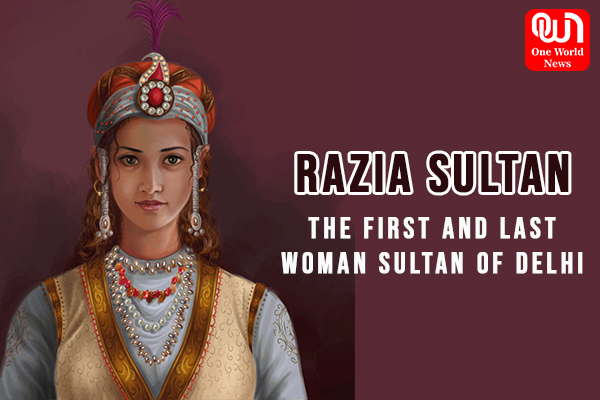History Notes: Who was Razia Sultan? Facts you need to know!
Razia Sultan: First women of Delhi Sultan to be called as Sultan
Razia Sultan was the daughter of Iltutmish. She was South Asia’s first Muslim Ruler with extreme talent, bravery and administration. She was a great warrior, born in 1205 belonging to Turkish Seljuks ancestry. Razia received training fighting, leading the army and about other administrations of the Kingdom. Being more competent than her brother, Sultan Iltutmish chooses Razia as his successor since the very beginning. Razia was made in charge of everything in the absence of Iltutmish in the Iltutmish’s reign. With the death of Iltutmish, Rukn-ud-din, Iltutnish’s son occupied the throne. In the year 1236, Razia overtook the throne by defeating her brother with Delhi’s support.

Points you should know about Razia Sultan and her Journey to the throne
● On 10th November, Razia Sultan took over the throne from her brother Rukn-ud-din, who ruled the empire for 7 years. She was officially named as Jalal – ud – din Raziya.
● She adopted a gender-neutral attire giving up the traditional attire of Muslim women that includes Pardah. This made her a fury to the conservative Muslims.
● According to the Muslim culture, Razia should be called as Razia Sultana but Razia refused to be addressed as ‘Sultana’. In Muslim culture, Sultana refers to the wife or the mistress of a Sultan, a ruler. She proclaimed herself as Sultan, the ruler.
● Razia is one of those women and very few female rulers who took the throne from the front. She was the fifth ruler of the Mamluk Dynasty who is an important figure in the Islamic Civilization all across the world.
● In her reign, she got coins minted with the title – “Pillar of Women, Queen of the Times, Sultan Razia, daughter of Shamsuddin Iltutmish.”
● Razia’s family was not from the Nobel class. The ancestral roots of Razia trace to Turkish Seljuk Slaves.
● Her father Iltutmish entered Delhi as a slave in the reign of Qutb all-in Aibak. Aibak later laid the foundation of the Mamluk Dynasty.
● Aibak found Iltutmish, brave and honest to hold the position of a provincial governor. Aibak trusted him enough and further offered his daughter, Qutub Begum’s hand in his hand for marriage.
● Aibak met an unfortunate death in a game called Chaugan in 1210. Aram Baksh took over the throne after Aibak.
● Aram was not really able to match the standards of a ruler. Some 40 Turkic novels commonly called Chihalgani who opposed Aram’s rule. Finally, they Iltutmish to succeed as Delhi’s Sultan.
● Aram Shah was furious of this all. Hence, Aram Shah and Iltutmish ended up in a battle on Bagh-i-Jud near Delhi, where Iltutmish defeated Aram. He ascend the throne in 1211.
● Iltutmish ruled for around 25 years and died in 236. The death of Iltutmish leads to great political turmoil in the Sultanate.
● No surviving son of Iltutmish was capable of taking and keeping the throne, hence history was written by making Razia, the Sultan of Delhi Sultanate.
● The nobles of the court did not support Razia much despite the fact that she was nominated by the Sultan himself. Runk-ud-din was raised as throne instead.
● Firuz got engaged in hedonistic pleasures and left the governance in the hands of his mother. On 9 November 1236, Firuz and his mother got assassinated and this time, Razia became the first Muslim Woman ruler of the Delhi Sultanate.
Read more: History Notes: Key Events of World War – I that you need to know
The Sultan- Razia
Razia, in no manner, was any less than the great Sultans of the Delhi Sultanate. She fought several battles on the forefront and lead to the seize of several territories. She had mastered the administration. She lead to the establishment of various schools, academies, research centres and libraries. The school preached the Quran and the work of People in Science, philosophy astronomy and literature.
Razia’s accession to the throne was however not very well. The Nobles from Turkish were not appreciating of the fact that a woman is with the throne. They were apprehensive and jealous of it. Hence, the made a plan to revolt against Razia. They hatched a conspiracy with Ikhtiar -ud – din Aitigin as the leader of the conspiracy. He was raised from the office Badaun.
Conclusion
A Muslim descendant of Turkish extraction invaded in India in the eleventh century writing the death of Razia. Razia died in 1240. Razia’s reign lasted for almost three and a half years. She brought a lot of big reforms in the education system and administration but unfortunately, could not stand alone in front of the Muslim Nobles. The rule of the women got subjected to the envyness and discontent of the masculine powers. Still, Razia became a display of power and bravery. She defied the Muslim tradition by ditching the veil and took the course on the battlefield. In her small span, she is definitely credited of being just and generous ruler.
For more such informative articles stay tuned to OWN TV.
